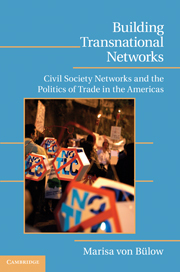Book contents
- Frontmatter
- Contents
- List of Figures
- List of Tables
- Acknowledgments
- Part One Civil Society Organizations and Their Pathways to Transnationality
- Part Two The Politicization of Trade
- 3 THE CONTENTIOUS NATURE OF TRADE DEBATES
- 4 NEW REGIONALISM IN THE AMERICAS
- Part Three The Dynamics of Networks
- Part Four Organizational Pathways to Transnationality
- Part Five The Search for Ideational Pathways
- Main Abbreviations Used
- Appendix A Lists of Interviews
- Appendix B Social Network Questionnaire (United States)
- Bibliography
- Index
4 - NEW REGIONALISM IN THE AMERICAS
Published online by Cambridge University Press: 05 October 2010
- Frontmatter
- Contents
- List of Figures
- List of Tables
- Acknowledgments
- Part One Civil Society Organizations and Their Pathways to Transnationality
- Part Two The Politicization of Trade
- 3 THE CONTENTIOUS NATURE OF TRADE DEBATES
- 4 NEW REGIONALISM IN THE AMERICAS
- Part Three The Dynamics of Networks
- Part Four Organizational Pathways to Transnationality
- Part Five The Search for Ideational Pathways
- Main Abbreviations Used
- Appendix A Lists of Interviews
- Appendix B Social Network Questionnaire (United States)
- Bibliography
- Index
Summary
At the end of the 1980s, the Americas became an important laboratory for new trade negotiations. Debates about trade liberalization were not, however, unknown to the region. The idea of free trade between the United States and Canada was over a century old when the two countries signed their free trade agreement in 1989. Similarly, the history of Latin America is punctuated by failed attempts to fulfill what many saw – at least rhetorically – as its “historical calling,” that is, to become united as one country. The first round of attempts at integration in the nineteenth century – some of which included the United States -collapsed under the weight of geographical distances, the power of caudillos (local strongmen), and the differing interests of the subregions.
A second round of attempts to integrate the region began in the 1950s, as part of a development strategy that aimed at industrializing Latin America. Between the 1950s and the mid-1980s, the United States and Latin America pursued antagonistic trade policies. Whereas in the United States the years following the Second World War inaugurated a period of trade liberalization, in Latin America this was the age of protectionism. Both of these strategies were influenced by the Cold War. In the United States, free trade was perceived as an important part of its anticommunist strategies, whereas in Latin America protectionist policies were considered a key tool in reaching autonomous economic development.
- Type
- Chapter
- Information
- Building Transnational NetworksCivil Society and the Politics of Trade in the Americas, pp. 49 - 64Publisher: Cambridge University PressPrint publication year: 2010

